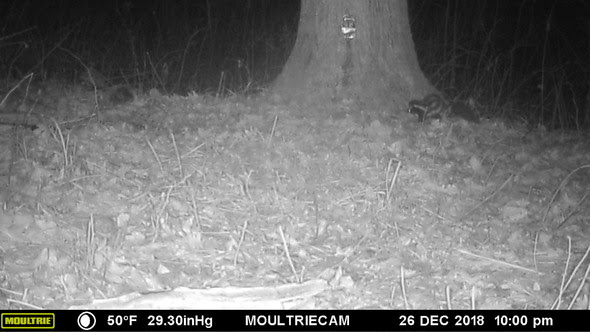 MONTGOMERY-Last month, Nongame Wildlife Biologists deployed game cameras at Freedom Hills WMA and Tuskegee National Forest in our ongoing effort to find Eastern Spotted Skunks a.k.a. “civet cat” or “polecat” in Alabama.Eastern spotted skunks, about the size of a fox squirrel, are much smaller than the more common striped skunk and were once common across the eastern United States. Today the species is rare and reasons for its decline are unclear. Current observations suggest spotted skunks still occur statewide in Alabama, but population numbers are low. They are more active in winter, making this the best season to capture them on camera.
MONTGOMERY-Last month, Nongame Wildlife Biologists deployed game cameras at Freedom Hills WMA and Tuskegee National Forest in our ongoing effort to find Eastern Spotted Skunks a.k.a. “civet cat” or “polecat” in Alabama.Eastern spotted skunks, about the size of a fox squirrel, are much smaller than the more common striped skunk and were once common across the eastern United States. Today the species is rare and reasons for its decline are unclear. Current observations suggest spotted skunks still occur statewide in Alabama, but population numbers are low. They are more active in winter, making this the best season to capture them on camera.
On December 26, Nongame Wildlife Biologist Keith Hudson captured this eastern spotted skunk at Freedom Hills WMA. This may be the first time the species has been documented on the WMA.
 The eastern spotted skunk is one of two species of skunk that inhabit the southern United States. The spotted skunk is a small, slender animal about the size of a squirrel. The fur is jet black with four to six horizontal white stripes on the neck and shoulders. The name spotted skunk is derived from the irregular elongated, vertical spots that are present along its sides and forelegs. The tail is tipped in white, while the head possesses a white triangular patch above the nose. The average weight of spotted skunks varies from one to one-and-one-half pounds, with males weighing approximately 10 percent more than females. Claws on the front feet are adapted for digging out prey species. The approximate length of the front claws is one-fourth inch — almost twice the length of the claws on the back feet.
The eastern spotted skunk is one of two species of skunk that inhabit the southern United States. The spotted skunk is a small, slender animal about the size of a squirrel. The fur is jet black with four to six horizontal white stripes on the neck and shoulders. The name spotted skunk is derived from the irregular elongated, vertical spots that are present along its sides and forelegs. The tail is tipped in white, while the head possesses a white triangular patch above the nose. The average weight of spotted skunks varies from one to one-and-one-half pounds, with males weighing approximately 10 percent more than females. Claws on the front feet are adapted for digging out prey species. The approximate length of the front claws is one-fourth inch — almost twice the length of the claws on the back feet.
LEARN MORE
Media Release/Alabama Department of Conservation and Natural Resources


